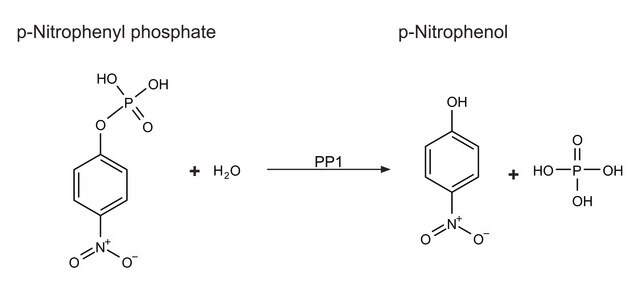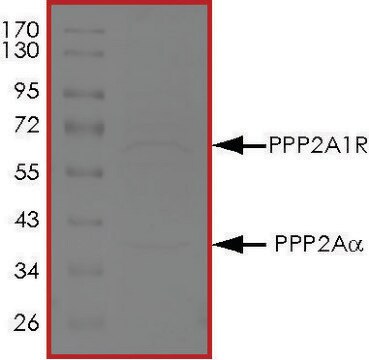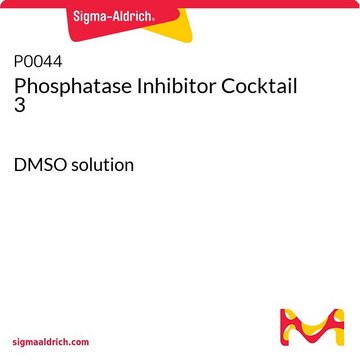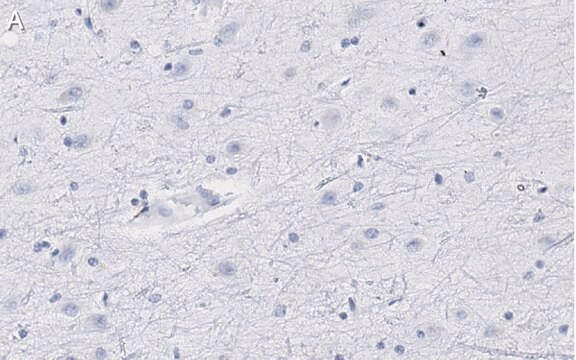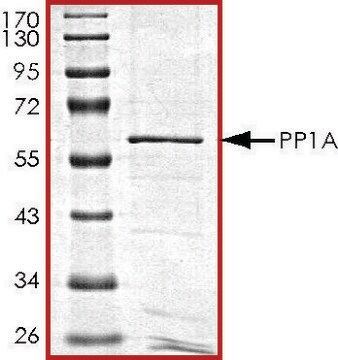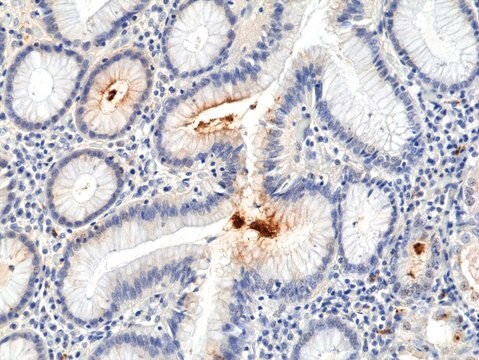14-595-M
PP1α Protein, 10 µg
Recombinant, full length, human PP1α, for use in Phosphatase Assays.
Synonym(s):
PPP1C, Phosphoprotein phosphatase 1, Phosphorylase phosphatase
Sign Into View Organizational & Contract Pricing
All Photos(1)
About This Item
UNSPSC Code:
12352200
eCl@ss:
32160405
NACRES:
NA.32
Recommended Products
biological source
human
Quality Level
recombinant
expressed in E. coli
form
solution
shelf life
6 mo.
mol wt
Mw 37.6 kDa
manufacturer/tradename
Upstate®
technique(s)
activity assay: suitable (phosphatase)
solubility
water: soluble
NCBI accession no.
UniProt accession no.
storage temp.
−20°C
Gene Information
human ... PPP1CA(5499)
General description
Research area: Neuroscience
Protein Phosphatase 1 (PP1) is one of the key serine/threonine-specific protein phosphatases.
Protein Phosphatase 1 (PP1) is one of the key serine/threonine-specific protein phosphatases.
Application
Research Category
Inflammation & Immunology
Inflammation & Immunology
Biochem/physiol Actions
Protein Target: PP1α Target Sub-Family: Ser/Thr phosphatase
Protein Phosphatase 1 (PP1) has been associated with a wide range of biological processes, including synaptic plasticity, cell cycle progression, dopaminergic neurotransmission, contraction, and glycogen metabolism, maintaining microtubule stability and the dephosphorylation of tau. Furthermore, PP-1 plays a vital role in synaptic development, plasticity, signaling, neurite outgrowth, synapse formation, ion channel function, and neurotransmission. Changes in PP-1 signaling within dendritic spines have been linked to various neurological and psychiatric disorders.
Protein Phosphatase 1 (PP1) has been associated with a wide range of biological processes, including synaptic plasticity, cell cycle progression, dopaminergic neurotransmission, contraction, and glycogen metabolism, maintaining microtubule stability and the dephosphorylation of tau. Furthermore, PP-1 plays a vital role in synaptic development, plasticity, signaling, neurite outgrowth, synapse formation, ion channel function, and neurotransmission. Changes in PP-1 signaling within dendritic spines have been linked to various neurological and psychiatric disorders.
Packaging
Also available in 250 µg size --call for pricing and availability and reference catalog number 14-595M when ordering the 250 µg size.
Quality
routinely evaluated by dephosphorylation of 100μM DiFMUP
Physical form
Heparin agarose followed by Q agarose
Storage and Stability
6 months at -20°C from date of shipment
Other Notes
For Specific Activity data, refer to the Certificate of Analysis for individual lots of this enzyme
Legal Information
UPSTATE is a registered trademark of Merck KGaA, Darmstadt, Germany
Disclaimer
Unless otherwise stated in our catalog or other company documentation accompanying the product(s), our products are intended for research use only and are not to be used for any other purpose, which includes but is not limited to, unauthorized commercial uses, in vitro diagnostic uses, ex vivo or in vivo therapeutic uses or any type of consumption or application to humans or animals.
signalword
Warning
hcodes
Hazard Classifications
Skin Sens. 1
Storage Class
12 - Non Combustible Liquids
wgk_germany
WGK 1
Certificates of Analysis (COA)
Search for Certificates of Analysis (COA) by entering the products Lot/Batch Number. Lot and Batch Numbers can be found on a product’s label following the words ‘Lot’ or ‘Batch’.
Already Own This Product?
Find documentation for the products that you have recently purchased in the Document Library.
The role of protein phosphatase-1 in the modulation of synaptic and structural plasticity.
Munton, Richard P, et al.
Febs Letters, 567, 121-128 (2004)
Alphonse Garcia et al.
Biochimie, 85(8), 721-726 (2003-10-31)
The reversible phosphorylation of proteins controlled by protein kinases and protein phosphatases is a major mechanism that regulates a wide variety of cellular processes. In contrast to C. elegans, recent studies in mammalian cells have highlighted a major role of
Hugo Ceulemans et al.
Physiological reviews, 84(1), 1-39 (2004-01-13)
The protein serine/threonine phosphatase protein phosphatase-1 (PP1) is a ubiquitous eukaryotic enzyme that regulates a variety of cellular processes through the dephosphorylation of dozens of substrates. This multifunctionality of PP1 relies on its association with a host of function-specific targetting
Patricia T W Cohen
Journal of cell science, 115(Pt 2), 241-256 (2002-02-13)
Protein phosphatase 1 (PP1) is a major eukaryotic protein serine/threonine phosphatase that regulates an enormous variety of cellular functions through the interaction of its catalytic subunit (PP1c) with over fifty different established or putative regulatory subunits. Most of these target
Our team of scientists has experience in all areas of research including Life Science, Material Science, Chemical Synthesis, Chromatography, Analytical and many others.
Contact Technical Service